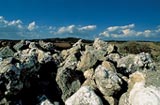

Non si può parlare di Volterra senza pensare all’alabastro, un
artigianato artistico che vanta una storia e una nobiltà di
tradizioni che si respirano in ogni angolo della città.
L’alabastro volterrano, costituito da solfato di calcio
idrato, è scavato nelle zone limitrofe alla città e fu usato
su larga scala fin dal periodo etrusco per la fabbricazione
delle urne cinerarie; moltissime sono conservate presso il
Museo Guarnacci e si fanno apprezzare per la finissima fattura
dei bassorilievi.
Il maggiore sviluppo della manifattura degli alabastri si ebbe
alla fine del settecento, con produzioni di altissimo pregio
che, grazie all’intraprendenza dei “viaggiatori
dell’alabastro”, raggiunsero ogni parte del mondo.
La lavorazione di questa pietra, calda e luminosa, si è
tramandata di padre in figlio per migliaia di anni e ancora
oggi rappresenta una delle massime espressioni
dell’artigianato artistico italiano. Il visitatore può trovare
a Volterra, nelle caratteristiche botteghe artigiane del
centro storico, dove la bianca polvere ovunque si spande e si
posa, e nelle numerose esposizioni, piccoli e grandi
capolavori tali da soddisfare ogni gusto.
|

You cannot talk about Volterra without mentioning Alabaster,
an artistic handi- craft that boasts a centuries-old history
and a nobility of traditions that can be felt in every nook
and corner of the town.
It is a calcareous substance mined in the surrounding area
that has been widely used for millennia since the Etruscan
craftsmen carved it to obtain urns to keep the ashes of their
dead.
Many of these cinerary urns are now exhibited in the Guarnacci
Museum where the visitor can appreciate all the exquisite
workmanship of the bas-reliefs.
At the end of the 18th century, after a long period during
which the craft of alabaster had virtually died out, Volterra
saw a new Renaissance, and workshops sprang up with a high
quality production that reached every part of the world,
thanks to the resourcefulness of the so-called “Alabaster
travellers”.
The secrets of the manufacture of this warm and luminous stone
have been handed down for ages from generation to generation,
and still represent one of the highest peaks of the italian
artistic handicraft.
In the characteristic workshops of the historic centre, where
everything is covered with white dust, or in the many displays
all around Volterra, the visitor will find great or small
masterpieces to satisfy any taste.
 |


Man kann nicht über Volterra sprechen, ohne den Alabaster zu
erwähnen, ein Kunsthandwerk, das sich bis auf die Etrusker
zurückverfolgen lässt, mit noblen Traditionen, die man in
jedem Winkel Volterras fühlt.
Der Alabaster von Volterra besteht aus einem Sulfat des
Kalziumhydrats, wird in der Umgebung der Stadt abgebaut und
wurde von den Etruskern in grossem Ausmass zur Herstellung
ihrer Aschenurnen verwendet.
Viele davon sind im Museum Guarnacci ausgestellt und fallen
unter anderem durch die feine Ausarbeitung der Basreliefs auf.
Das Handwerk erfuhr Ende des 18. Jh. einen Aufschwung, mit der
Herstellung von Gegenständen von hohem künstlerischem Niveau
und einem weltweiten Verkauf durch das Engagement der “Alabaster-Reisenden”.
Die Verarbeitung dieses warmen und durchscheinenden Steines
wurde über Jahrtausende von Vater zum Sohn weitervererbt und
ist auch heute noch eine der wichtigsten Ausdrücke des
italienischen Kunsthandwerks.
Der Besucher kann in den Ausstellungen und den
charakteristischen Werkstätten, in denen der weisse Staub
ständig in der Luft liegt und sich auf alles absetzt, im
historischen Zentrum Volterras, kleine und grosse Meisterwerke
finden, die jedem Geschmack entsprechen. |